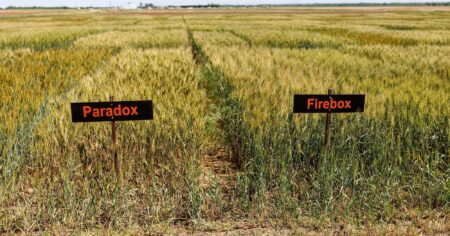Early season weed control sets the tone for the rest of the growing season.
Delayed herbicide applications allow weeds to grow larger and harder to manage, ultimately reducing yield. “The only way to maximize your corn yield is to stay clean the entire season,” said Shawn Hock, U.S. corn herbicide brand manager for Syngenta. “Two- to 4-inch waterhemp can consume 13.4 pounds of nitrogen, costing up to $24 an acre.”
Winter annual and early summer annual weeds compete with crops for moisture, nutrients, and sunlight. They can also interfere with planting and serve as hosts for harmful insects. “We need to control weeds when they’re most vulnerable — before they emerge,” Hock said. “With how tough weeds are to control today, we need to start with the right herbicides to keep fields clean.”
Balancing Weed Control With Early Planting
The planting window between corn and soybeans is narrowing. “I looked at USDA data for when 50% of corn and soybeans are planted,” said Hock. “That gap used to be 30 days. Now it’s about 17 days and shrinking.”
Earlier planting demands longer-lasting weed control. Hock recommends strong premixed herbicides with multiple active ingredients and safening technology that performs well in varied spring conditions. “In corn, our products like Acuron and Storen contain the active ingredient bicyclopyrone, which offers burndown activity,” Hock said. “We typically recommend using them alongside another herbicide like AAtrex (atrazine) or a PPO product like Oxone to help control emerged weeds and also provide strong residual control.”
Dealing With Compressed Springs
According to the University of Illinois, early April in the Midwest brought cooler-than-normal temperatures and highly variable rainfall, ranging from well below normal in some areas to over 8 inches in others.
Compressed planting windows due to rain or cold temperatures are common challenges, said Kurt Maertens, BASF technical agronomist. Maertens recommends products like Zidua Pro for soybeans, which contains three active ingredients — Sharpen, Pursuit, and Zidua — for fast burndown and residual control. “Not only are we able to burndown but also put out a residual at the same time,” he said. “It also provides a zero-day plant back so we can get weeds taken care of, a residual on, and planters rolling.”
If weeds are already large due to delays, Maertens advises increasing rates, using tank mixes with glyphosate or 2,4-D, and enhancing adjuvants. “We have to scout and adjust burndown strategies based on weed size and species,” he said.
Soybean Postemergence Options Without Dicamba
For Xtend soybeans without over-the-top dicamba, proactive planning is essential. “Start strong with a residual that has multiple effective sites of action,” Maertens said.
Larry Steckel, University of Tennessee Extension weed specialist, suggests preemergence tank mixes with active ingredients like metolachlor, pyroxasulfone, or acetochlor, paired with metribuzin, flumioxazin, fomesafen, saflufenacil, or sulfentrazone. These should be followed by early postemergence residuals such as metholachlor or acetochlor.
Postemergence control of pigweed species, like Palmer amaranth, is especially challenging in areas with populations of multiple resistances. “Liberty is the last best postemergence option, but it must be applied to weeds less than 4 inches tall,” Steckel said. “Logistically, getting every field sprayed before this fast-growing weed exceeds 4 inches is difficult, if not impossible.” For large pigweeds, he recommends two Liberty applications spaced seven days apart.
Maertens suggests layering Liberty Ultra with glyphosate and a Group 15 product like Outlook to extend residual control. “Scouting is essential — you need to know what weeds are present and act before they get the upper hand,” he added.
Efficiency and Adaptability Are Key
Operational efficiency can pay off big. “If you can cut 15 minutes off each sprayer fill-up using premixes, that could save 50 hours over a season,” said Hock.
Above all, stay flexible. “Once your crop is in, you should be scouting weekly,” Maertens said. “Know what weeds are out there and how big they are — so you can adapt before yield is on the line.”


:max_bytes(150000):strip_icc()/DC-5ec71dd349104ec287b318f05ebf5f74.jpg)
:max_bytes(150000):strip_icc()/SFCE_Sp25_WortheyFarmersMarket_preview1-9c3c0b2c5e9444249fa60594b7f30fec.jpg)
:max_bytes(150000):strip_icc()/TaylorsFireworkssign-c3dd3eb41cc646c593dbebfee850bdc0.jpg)


:max_bytes(150000):strip_icc()/EmergingsoybeansFMC_preview-07bcbcef377943d1aef60a3c75591b51.jpg)

:max_bytes(150000):strip_icc()/diseaseplaybookcorntarspot-fb7ff9d7c32e4e63b3e5e97dbe406eeb.jpg)
